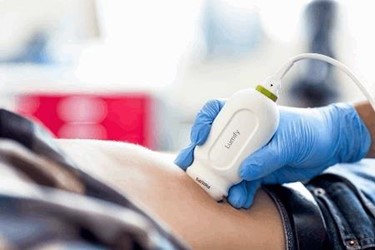Philips Gets FDA Clearance For Lumify Cardiac Transducer
By Jof Enriquez,
Follow me on Twitter @jofenriq

Royal Philips says it has received 510(k) clearance from the U.S. Food and Drug Administration (FDA) for the Lumify ultrasound device's S4-1 transducer, which allows high-resolution imaging for abdominal and cardiac applications, including echo, OB/GYN, lung, abdomen, and focused assessment with sonography for trauma (FAST) imaging preset optimizations.
Launched in June last year, Lumify is Philips' first app-based ultrasound solution, which pairs three types of Philips-made transducers with commercially available Android devices and tablets. Data collected via a mobile app is stored in Philips’ HealthSuite digital cloud-based platform.
Lumify is a point-of-care diagnostic device designed for use in both emergency care units and office settings. The device is available through either a scalable subscription model or outright purchase and is marketed for ambulatory and home use by healthcare professionals.
In August, Philips and Mayo Clinic used Lumify and other "smart" devices to measure heart and lung function among mountaineers climbing Mt. Kilimanjaro. Their research will help shape the future of cardiovascular diagnostics and care, according to Philips, which also has brought these devices to clinical settings.
"Lumify is a game-changing innovation," said Dr. John Bailitz, emergency ultrasound physician and leader with ACEP and the Social Media and Critical Care (SMACC) organization, in a news release. "The affordability, flexibility and versatility of Lumify make it appealing to those working in emergency settings, and now with the S4-1 cardiac probe and FAST exam pre-sets, we can conduct critical exams at the point-of-care, resulting in more efficient triage of patients."
The S4-1 transducer (and cable) weighs 152 grams and is smaller than a smartphone. It features a 4-to-1 MHz extended operating frequency range and is capable of 2D, color Doppler, M-mode, advanced XRES, and multivariate harmonic high-resolution imaging for abdominal and cardiac applications. It stores data on the Philips HealthSuite Digital Platform, a cloud-based IT infrastructure that will facilitate collaborative care and allow access to research-enhancing analytics. Lumify also connects with picture archiving and communication systems (PACS), shared networks and system directories.
Lumify's two other transducers are the C5-2 broadband curved array transducer and the L12-4 broadband linear array transducer. The C5-2 transducer is used in high-resolution imaging for deeper applications: abdominal, gall bladder, OB/GYN and lung imaging preset optimizations. The L12-4 transducer is for high-resolution imaging for shallow applications: soft tissue, vascular, superficial, musculoskeletal, and lung.
Now with a full suite of point-of-care transducers, Lumify represents one of the more prominent devices in the point-of-care (POC) market, which was the fastest-growing segment of the ultrasound equipment market in 2014, and is projected to continue to outstrip other segments over the next decade, according to iData Research.
"Our vision for smart-device ultrasounds is focused on putting high-quality devices in the hands of more professionals to serve more patients in more locations," said Randy Hamlin, VP and Point-of-Care Business Leader for Philips Ultrasound.
